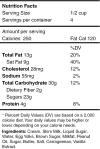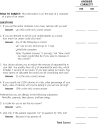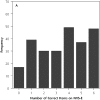Quick assessment of literacy in primary care: the newest vital sign
- PMID: 16338915
- PMCID: PMC1466931
- DOI: 10.1370/afm.405
Quick assessment of literacy in primary care: the newest vital sign
Erratum in
- Ann Fam Med. 2006 Jan-Feb;4(1):83
Abstract
Purpose: Current health literacy screening instruments for health care settings are either too long for routine use or available only in English. Our objective was to develop a quick and accurate screening test for limited literacy available in English and Spanish.
Methods: We administered candidate items for the new instrument and also the Test of Functional Health Literacy in Adults (TOFHLA) to English-speaking and Spanish-speaking primary care patients. We measured internal consistency with Cronbach's alpha and assessed criterion validity by measuring correlations with TOFHLA scores. Using TOFLHA scores <75 to define limited literacy, we plotted receiver-operating characteristics (ROC) curves and calculated likelihood ratios for cutoff scores on the new instrument.
Results: The final instrument, the Newest Vital Sign (NVS), is a nutrition label that is accompanied by 6 questions and requires 3 minutes for administration. It is reliable (Cronbach alpha >0.76 in English and 0.69 in Spanish) and correlates with the TOFHLA. Area under the ROC curve is 0.88 for English and 0.72 for Spanish versions. Patients with more than 4 correct responses are unlikely to have low literacy, whereas fewer than 4 correct answers indicate the possibility of limited literacy.
Conclusion: NVS is suitable for use as a quick screening test for limited literacy in primary health care settings.
Figures






References
-
- Nielson-Bohlman L, Panzer A, Kindig D, eds. Health Literacy: A Prescription to End Confusion. Washington, DC: National Academies Press; 2004. - PubMed
-
- Berkman N, DeWalt D, Pignone M, et al. Literacy and Health Outcomes. Summary, Evidence Report/Technology Assessment No. 87 (Prepared by RTI International - University of North Carolina Evidence-Based Practice Center under Contract No. 290-02-0016). Rockville, Md: Agency for Healthcare Research and Quality; 2004. AHRQ Publication No. 04-E007-1.
-
- Schwartzberg J, VanGeest J, Wang C, eds. Understanding Health Literacy: Inspirations for Medicine and Public Health. Chicago, Ill: American Medical Association Press; 2004.
-
- US Department of Health and Human Services. Health Communication. In: Healthy People 2010. 2nd ed. Washington, DC: US Government Printing Office; 2000.
-
- Gottfredson L. Why g matters: the complexity of everyday life. Intelligence. 1997;24:79–132.
Publication types
MeSH terms
LinkOut - more resources
Full Text Sources
Medical
